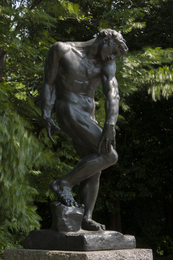Updated 10 June 2025
On Display Forecourt
Adam
| Date | 1881 (model) |
|---|---|
| Materials and Techniques | bronze |
| Size(cm) | 198 x 76 x 84 |
| Inscriptions | Signed right side of base: Rodin; Foundry mark right back of base: Alexis. Rudier / fondeur. Paris |
| Credit Line | Matsukata Collection |
| Standard ref. | M1249 |
| Category | Sculptures |
| Collection Number | S.1959-0001 |
Rodin traveled to Italy in 1875, and returned to France having been greatly influenced by Michelangelo. Almost immediately after his return to France, Rodin created a figure of Adam to understand the art of Michelangelo. He was not satisfied with this work, however, as it was too exact a copy of Michelangelo's sculpture, and in the end he destroyed it. When he began formulating his ideas for The Gates of Hell, Rodin decided to place monumental figures on either side of the gates. He decided that Adam and Eve, the originators of mankind's Original Sin, were the most appropriate figures to place in these positions. Rodin used Caillou, a strong artist known as the "Iron Jawed Man," as the model for his depiction of Adam. One of The Three Shades who stand on top of The Gates of Hell has the same upper body as Adam, but is shown in a less twisted and deformed form, exhibiting an overall calm demeanor. The Three Shades were probably created in the process of creating Adam. The image of Christ in the Pièta by Michelangelo in the Florence Cathedral can be clearly seen as an influence on Adam's physique and form. Also, we can imagine Adam's fingers receiving life from God in The Creation of Adam in the Sistine Chapel ceiling frescos, in the expression of the fingers on Adam's right hand. When a plaster cast of this work was exhibited in the 1881 Salon, it was called The Creation of Mankind. (Source: Masterpieces of the National Museum of Western Art, Tokyo, 2009, cat. no. 131)
Provenance
Bought from Musée Rodin by Kojiro Matsukata, Kobe through Léonce Bénédite, 1919, as ‘Adam’ (Fr. 35,000) [see order records of bronze casting ‘Adam’ and several letters between Bénédite and Suzuki & Co., August 1919, in Archives of Musée Rodin, Paris; copy in NMWA curatorial files]; sequestered by French government, 1944; vested in French government under San Francisco Peace Treaty, 1952; transferred by French to Japanese government, 23 January 1959; entered into NMWA, April 1959.
Exhibition History
- 1966
- Rodin, National Museum of Western Art, Tokyo, 23 July 1966 - 11 September 1966, cat. no. 15
- 1989
- Rodin et la Porte de l’Enfer (Rodin and the Gates of Hell), National Museum of Western Art, Tokyo, 21 October 1989 - 17 December 1989, cat. no. 4
Bibliography
- 1989
- Goldscheider, Cécile. Rodin, vie et œuvre, Tome I. Paris, Wildenstein Institute, 1989, pp. 152-153, no. 114.
- 1990
- The Old Matsukata Collection. Kobe City Museum, ed. Kobe, "Matsukata Korekushon Ten" Jikkoiinkai, 1990, cat. no. S-15.
- 2006
- Masterpieces of The National Museum of Western Art, Tokyo. Tokyo, The National Museum of Western Art; Tokyo, The Western Art Foundation, 2006 (Japanese, preface in Japanese and English), no. 131, repr.
- 2009
- Masterpieces of The National Museum of Western Art, Tokyo. Tokyo, The National Museum of Western Art; Tokyo, The Western Art Foundation, 2009, no. 131, repr.
- 2013
- Masterpieces: The National Museum of Western Art, Tokyo. Tokyo, The Western Art Foundation, 2013 (Japanese, preface in Japanese and English), no. 130, col. repr.
- 2019
- The Matsukata Collection: Complete Catalogue of the European Art. Kawaguchi, Masako; Jingaoka, Megumi, eds. vol. 2: Sculpture, Drawings, Prints and Decorative Arts and Other Works, Tokyo, The National Museum of Western Art, Tokyo, 2019, cat. no. 1249, col. repr.












